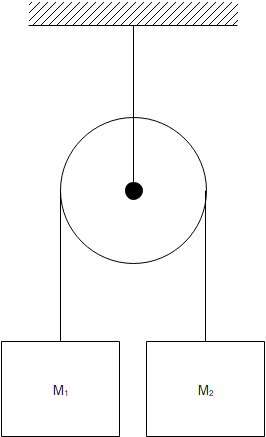
The masses

(A)
(B)
(C)
(D)
Answer
147k+ views
1 likes
Hint We should know that the work-energy theorem gives us an idea that the net work done by the forces on an object which is equal to the change in the kinetic energy of the body. Based on this theorem we have to answer this question.
Complete step by step answer
We should know that the expression for the diagram is given as:
Now the expression is evaluated as:
In this case,
So, the expression now is given as:
So, the value of V after the evaluating is given as:
So, the correct answer is Option B.
Note From the work-energy theorem we get an idea that the new work that is occurring on the object will cause a change in the kinetic energy of the object. The main formula is given as net work equals the change in the kinetic energy which is also similar to the difference between final kinetic energy and the initial kinetic energy.
Complete step by step answer
We should know that the expression for the diagram is given as:
Now the expression is evaluated as:
In this case,
So, the expression now is given as:
So, the value of V after the evaluating is given as:
So, the correct answer is Option B.
Note From the work-energy theorem we get an idea that the new work that is occurring on the object will cause a change in the kinetic energy of the object. The main formula is given as net work equals the change in the kinetic energy which is also similar to the difference between final kinetic energy and the initial kinetic energy.
Recently Updated Pages
How to find Oxidation Number - Important Concepts for JEE

How Electromagnetic Waves are Formed - Important Concepts for JEE

Electrical Resistance - Important Concepts and Tips for JEE

Average Atomic Mass - Important Concepts and Tips for JEE

Chemical Equation - Important Concepts and Tips for JEE

Concept of CP and CV of Gas - Important Concepts and Tips for JEE

Trending doubts
JEE Main 2025 Session 2: Application Form (Out), Exam Dates (Released), Eligibility, & More

JEE Main Exam Marking Scheme: Detailed Breakdown of Marks and Negative Marking

JEE Main 2025: Derivation of Equation of Trajectory in Physics

Electric Field Due to Uniformly Charged Ring for JEE Main 2025 - Formula and Derivation

JEE Main Participating Colleges 2024 - A Complete List of Top Colleges

Degree of Dissociation and Its Formula With Solved Example for JEE

Other Pages
JEE Advanced Marks vs Ranks 2025: Understanding Category-wise Qualifying Marks and Previous Year Cut-offs

JEE Advanced 2025: Dates, Registration, Syllabus, Eligibility Criteria and More

Units and Measurements Class 11 Notes: CBSE Physics Chapter 1

NCERT Solutions for Class 11 Physics Chapter 1 Units and Measurements

Motion in a Straight Line Class 11 Notes: CBSE Physics Chapter 2

JEE Advanced Weightage 2025 Chapter-Wise for Physics, Maths and Chemistry




